A&P Unit 2: Bone Function, Classification, and Long Bone Formation
1/60
There's no tags or description
Looks like no tags are added yet.
Name | Mastery | Learn | Test | Matching | Spaced |
|---|
No study sessions yet.
61 Terms
What are the five functions of bone?
Support Movement
Protection
Calcium Storage
Calcium Homeostasis
Blood Cell Production
How do bones support movement?
they act as levers when muscles span a joint and contract
How do bones provide protection?
they surround and shield vital organs from injury and trauma, such as the skull protecting the brain and the ribcage safeguarding the heart and lungs.
What are the two types of marrow in bones?
red marrow and yellow marrow
Yellow Marrow
found in the center of a bone
stores fat
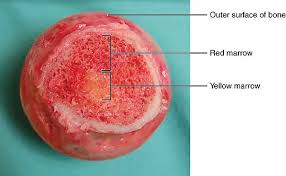
Red Marrow
surrounds yellow bone marrow
responsible for hematopoiesis

Hematopoiesis
blood cell production
Bones are classified according to their shape. What are a few examples of different bone classifications?
Flat Bones
Long Bones
Irregular Bones
Short Bones
Sesamoid Bones
Long Bone
A bone that is larger in length than width
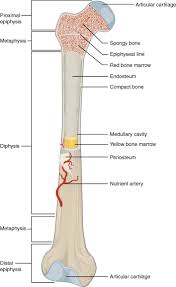
The ____ and ____ line bones inside and out!
periosteum; endosteum
Periosteum
forms the outer surface of the bone
Endosteum
lines the medullary cavity
Osteoblast
forms bone matrix
Osteocyte
the primary cell found in mature bone, and is responsible for maintaining bone tissue
Osteogenic Cell
bone stem cells that differentiate into osteoblasts, which are responsible for building new bone tissue
Osteoclast
responsible for breaking down and reabsorbing bone cells
Flat Bone
spongey bone with compact bone on top and bottom
protects internal organs
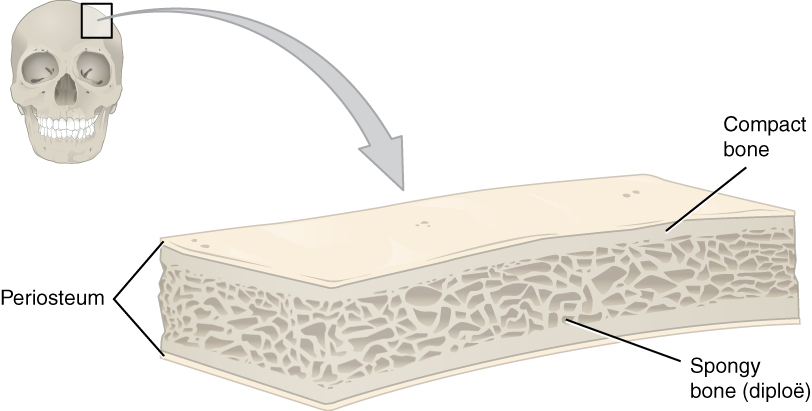
Where is spongey bone found?
the interior of bones
Describe the characteristics of spongey bone.
it is a less dense, porous type of bone
Why is spongey bone important?
it provides a balance between strength and lightness, making it more suited for metabolic functions and facilitation the production of blood cells (hematopoiesis)
What does spongey bone lack?
the highly organized osteons found in compact bone
What occurs in the spaces found in the lattice-like structure of spongey bone?
blood cell production
Are osteocytes found in spongey bone?
yes
What is another name for compact bone?
cortical bone
What does compact bone do? Why is that important?
it forms the dense outer layer of bones, which makes it very strong and suitable for weight bearing and protection
What is the primary structural unit of compact bone?
osteon
What does an osteon consist of?
concentric rings of bone tissue surrounding a central canal called the Haversian canal

The Haversian Canal
a canal that contains blood vessels, nerves, and connective tissue
this network supplies and nourishes bone tissue
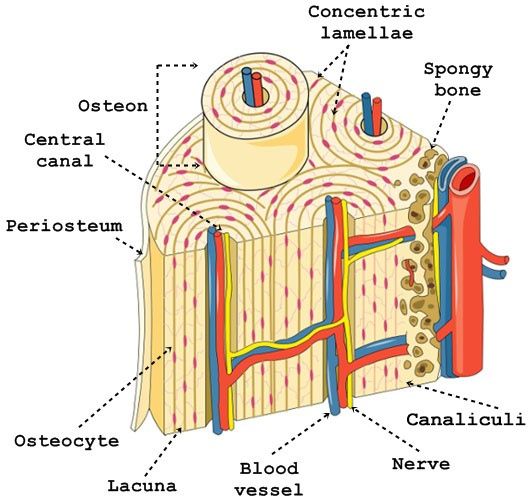
What surrounds the Haversian Canal?
concentric lamellae
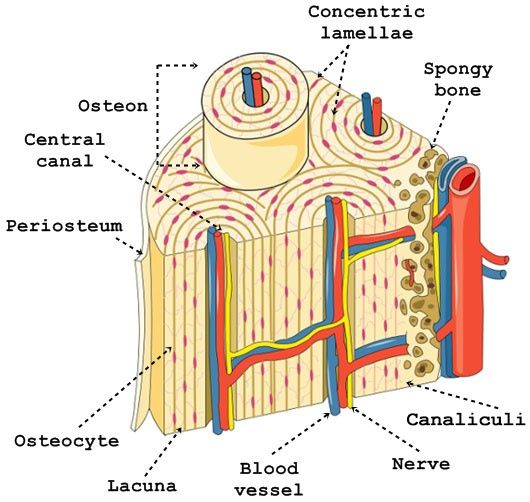
Lamellae
layers of mineralized extracellular matrix (mainly collagen), where bone cells are located
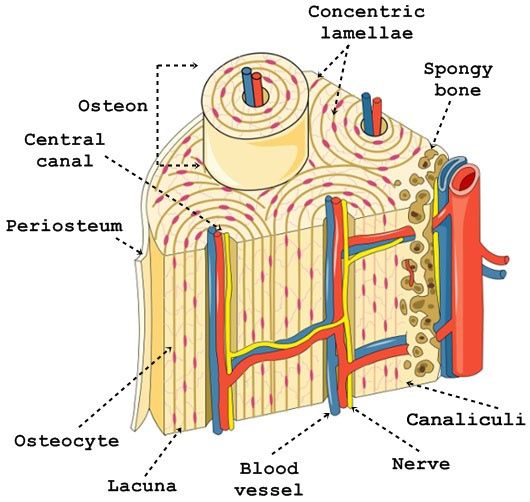
Where are osteocytes found?
in lacunae
Lacunae
small spaces between the lamellae
______ are tiny channels that connect osteocytes to the Haversian Canal, allowing for nutrient and waste exchange between cells.
Canaliculi
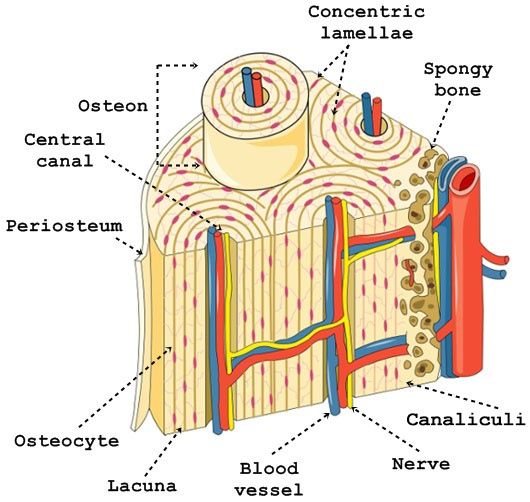
What is compact bone highly resistant to?
bending and twisting forces
Osteogenesis
the formation of bone
What are the two ways in which bone develops in the human fetus and infant?
intramembranous ossification
endochondral ossification
How do osteoblasts become osteocytes?
Osteoblasts become osteocytes by embedding themselves within the calcified matrix they create, eventually maturing and maintaining the bone tissue
What does Intramembranous Ossification produce?
flat bones, such as those in the skull and clavicle.
Intramembranous Ossification thickens…
long bones throughout life
Describe the steps of Intramembranous Ossification.
Mesenchymal cells begin to cluster and differentiate into osteoblasts
The osteoblasts secrete an un-calcified bone matrix called the osteoid, which hardens and traps the osteoblasts within it
The osteoblasts then differentiate into osteocytes
The osteoid develops around blood vessels, forming thin columns and plates of bone called trabeculae
The trabeculae will eventually form spongey bone
The periosteum forms around the bone and the compact bone develops superficial to the trabecular bone
What does Endochondral Ossification produce?
long bones
What are the six steps of Endochondral Ossification
Mesenchymal cells differentiate into chondrocytes
The cartilage model of the future bony skeleton and the perichondrium form
Capillaries penetrate cartilage. Perichondrium transforms into periosteum. Periosteal collar develops. Primary ossification center develops.
Cartilage and chondrocytes continue to grow at ends of the bone
Secondary ossification centers develop
Cartilage remains at the epiphyseal plate and at joint surfaces as articular cartilage
What is the epiphyseal plate responsible for?
longitudinal bone growth
What happens at the epiphyseal plate?
cartilage grows within the epiphseal plate, and then is replaced with bone
Describe the composition of the epiphyseal plate.
it has typical hyaline cartilage in the middle with transition zones on each side where cartilage is replaced by bone
What is the Metaphysis?
The region of long bones between the epiphysis and the diaphysis, where active growth occurs.
Bone elongation is a result of ____ growth within the epiphyseal plate
cartilage
When do epiphyses close?
when cartilage is gone
Longitudinal growth occurs from ____ a bone.
within
Appositional growth
bone widening and thickening
Appositional growth occurs at bone _______.
surfaces
Describe the process of appositional growth in terms of intramembranous ossification
Osteoblasts of inner periosteum deposits osteoid tissue and becomes trapped as tissue calcifies
They lay down matrix in layers parallel to the surface
forms circumferential lamellae
osteoclasts of endosteum enlarge marrow cavity
At what age does endochondral ossification, longittudinal bone growth, stop?
by late teens to early 20s
When endochondrial ossification stops, what three things happen?
the gap between epiphyses and diaphysis close
primary and secondary marrow cavities unite into a single cavity
bone can no longer grow in length
As the bone matures, the epiphyseal plate transitions into an ____ ____.
epiphyseal line
Wolff’s Law
the body conforms and adapts in the directions and intensities it is habitually subjected to
Bone remodeling and growth occur in response to ____ ____.
mechanical stress
What gender loses bone mass more rapidly after the age of 30?
women
What other factors affect bone growth?
hormones
vitamins
growth factors
Bone growth is especially rapid in puberty and adolescence due to the presence of what hormones?
surges in growth hormone, estrogen, and testosterone
What affect does steroids have on adolescents?
it causes premature closure of the epiphyseal plate, and results in abnormally short adult stature